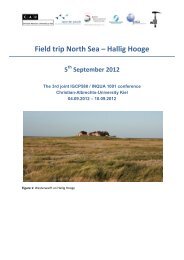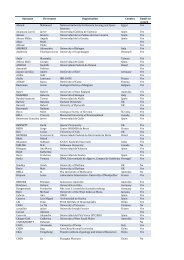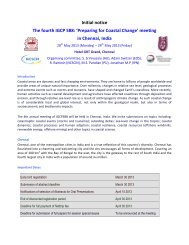Conference program and abstracts - Coastal-Change.Org
Conference program and abstracts - Coastal-Change.Org
Conference program and abstracts - Coastal-Change.Org
Create successful ePaper yourself
Turn your PDF publications into a flip-book with our unique Google optimized e-Paper software.
Vulnerable Deltas of Indian Coast<br />
Prof . Ramesh Ramach<strong>and</strong>ran <strong>and</strong><br />
Dr. Purvaja Ramach<strong>and</strong>ran<br />
National Centre for Sustainable <strong>Coastal</strong> Management. Chennai<br />
ABSTRACT<br />
Deltas are highly productive, ecologically rich <strong>and</strong> are dependent on the<br />
interaction between the river’s sediment, water <strong>and</strong> nutrient flux <strong>and</strong> the<br />
wave <strong>and</strong> tidal currents. A recent study indicates that most of the world’s<br />
low-lying river deltas are sinking <strong>and</strong> making them increasingly vulnerable<br />
to flooding from rivers <strong>and</strong> ocean storms exposing tens of millions of<br />
people at risk. At present nearly 500 million people live in deltas. In South<br />
Asia the population densities exceed 1000 people km-2 when compared<br />
to a global average of 45 people km-2.<br />
Problems associated with this include depleted fresh water supplies, l<strong>and</strong><br />
subsidence <strong>and</strong> erosion, sea level rise, infrastructure development, salt<br />
water intrusion, habitat loss <strong>and</strong> the threat of natural disasters. Sinking of<br />
deltas in Indian coast is enhanced by the upstream trapping of sediments<br />
by reservoirs <strong>and</strong> dams that retain these sediments. In this paper, an<br />
attempt is made to highlight some of the vulnerabilities, as a result of the<br />
changes in some of the major delta regions of India:<br />
a) Reduction of sediment load <strong>and</strong> freshwater flow<br />
b) Subsidence<br />
c) <strong>Coastal</strong> erosion<br />
d) Habitat loss<br />
Additionally, GIS mapping has been used as a management tool that<br />
allows the identification of such vulnerable zones, i.e. zones which are<br />
both sensitive <strong>and</strong> subject to risks. In this way, it is possible to build models<br />
for geomorphological evolution, prediction of changes <strong>and</strong><br />
management of deltas <strong>and</strong> coastal areas.<br />
The Fourth IGCP 588: PREPARING FOR COASTAL CHANGE 27





